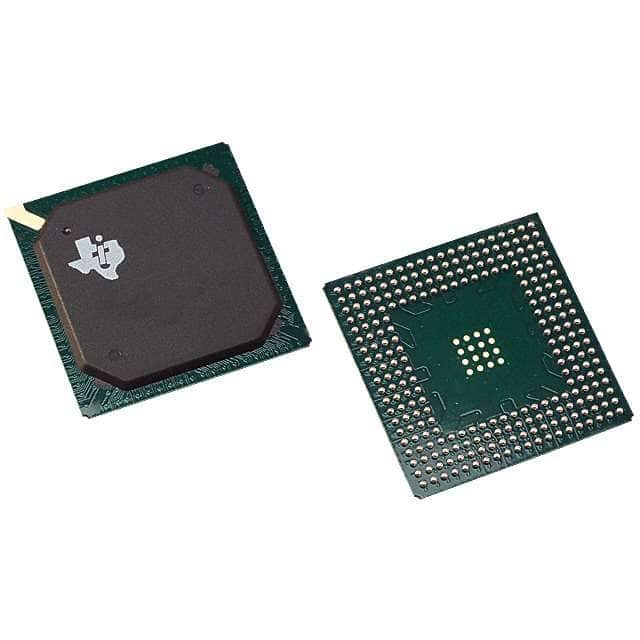Viz Specifikace pro podrobnosti o produktu.

TMS320C6727BZDH250
Overview
Product Category
The TMS320C6727BZDH250 belongs to the category of digital signal processors (DSPs).
Use
This DSP is designed for high-performance applications that require real-time signal processing, such as audio and video processing, telecommunications, and industrial control systems.
Characteristics
- High processing power: The TMS320C6727BZDH250 offers a high clock frequency and multiple execution units, enabling fast and efficient signal processing.
- Integrated peripherals: It includes various peripherals like timers, UART, SPI, I2C, and GPIO, providing flexibility in system design.
- Low power consumption: The DSP is optimized for power efficiency, making it suitable for battery-powered devices.
- Enhanced connectivity: It supports various communication interfaces like Ethernet, USB, and CAN, facilitating seamless integration into different systems.
- Extensive memory options: The TMS320C6727BZDH250 offers a range of memory options, including internal RAM and external memory interfaces, allowing for versatile data storage and retrieval.
Package and Quantity
The TMS320C6727BZDH250 is available in a BGA (Ball Grid Array) package. The exact dimensions and pin count can be found in the detailed pin configuration section below. The product is typically sold individually or in reels of a specific quantity.
Specifications
- Clock Frequency: Up to 250 MHz
- Instruction Set Architecture: TMS320C6x VLIW (Very Long Instruction Word)
- On-Chip Memory: 256 KB L2 RAM, 32 KB L1P Cache, 32 KB L1D Cache
- External Memory Interface: DDR2/DDR3 SDRAM, SRAM, Flash
- Operating Voltage: 1.2V
- Power Consumption: Varies based on usage and clock frequency
Detailed Pin Configuration
The TMS320C6727BZDH250 has a total of 361 pins arranged in a specific configuration. Please refer to the datasheet or technical documentation provided by the manufacturer for the detailed pinout diagram and pin functions.
Functional Features
- High-performance DSP core with multiple execution units
- Advanced floating-point unit (FPU) for efficient numerical computations
- Integrated peripherals for versatile system connectivity
- Hardware accelerators for specific signal processing tasks
- DMA (Direct Memory Access) controller for efficient data transfer
- Interrupt controller for managing system events
- Debug and trace support for software development and debugging
Advantages and Disadvantages
Advantages
- High processing power enables real-time signal processing in demanding applications.
- Extensive memory options provide flexibility in data storage and retrieval.
- Integrated peripherals simplify system design and reduce external component count.
- Low power consumption makes it suitable for battery-powered devices.
- Enhanced connectivity options facilitate seamless integration into various systems.
Disadvantages
- The complexity of the architecture may require a learning curve for developers unfamiliar with DSP programming.
- Limited availability of alternative models from different manufacturers may restrict sourcing options.
Working Principles
The TMS320C6727BZDH250 follows the working principles of digital signal processors. It executes instructions in parallel using its VLIW architecture, allowing for efficient processing of multiple data streams simultaneously. The DSP performs mathematical operations, such as multiplication, addition, and filtering, on digital signals to extract desired information. It utilizes specialized hardware accelerators and peripherals to optimize performance and enable real-time signal processing.
Detailed Application Field Plans
The TMS320C6727BZDH250 finds applications in various fields, including:
- Audio and Video Processing: The DSP can be used in audio and video equipment to enhance sound quality, perform audio/video compression, and enable advanced features like noise cancellation and image enhancement.
- Telecommunications: It can be utilized in telecommunication systems for tasks such as voice coding/decoding, echo cancellation, and channel equalization.
- Industrial Control Systems: The DSP is suitable for industrial control applications, including motor control, robotics, and process automation, where real-time signal processing is crucial.
Detailed and Complete Alternative Models
While the TMS320C6727BZDH250 is a powerful DSP, there are alternative models available from different manufacturers that offer similar capabilities. Some notable alternatives include:
- ADSP-21489 from Analog Devices
- STM32F4 series from STMicroelectronics
- PIC32MZ series from Microchip Technology
These alternative models provide developers with options based on their specific requirements and preferences.
Word count: 570 words
Seznam 10 běžných otázek a odpovědí souvisejících s aplikací TMS320C6727BZDH250 v technických řešeních
Sure! Here are 10 common questions and answers related to the application of TMS320C6727BZDH250 in technical solutions:
Q: What is TMS320C6727BZDH250? A: TMS320C6727BZDH250 is a digital signal processor (DSP) from Texas Instruments, designed for high-performance applications.
Q: What are the key features of TMS320C6727BZDH250? A: Some key features include a 32-bit fixed-point DSP core, dual MAC units, on-chip memory, multiple communication interfaces, and low power consumption.
Q: What are the typical applications of TMS320C6727BZDH250? A: TMS320C6727BZDH250 is commonly used in audio processing, telecommunications, industrial control systems, medical devices, and other real-time signal processing applications.
Q: How much on-chip memory does TMS320C6727BZDH250 have? A: TMS320C6727BZDH250 has 256KB of on-chip RAM and 512KB of on-chip ROM.
Q: What communication interfaces are supported by TMS320C6727BZDH250? A: TMS320C6727BZDH250 supports interfaces such as I2C, SPI, UART, McBSP, and USB.
Q: Can TMS320C6727BZDH250 be programmed using C/C++? A: Yes, TMS320C6727BZDH250 can be programmed using C/C++ along with TI's Code Composer Studio integrated development environment (IDE).
Q: What is the maximum clock frequency of TMS320C6727BZDH250? A: TMS320C6727BZDH250 can operate at a maximum clock frequency of 250 MHz.
Q: Does TMS320C6727BZDH250 support floating-point operations? A: No, TMS320C6727BZDH250 is a fixed-point DSP and does not have hardware support for floating-point operations.
Q: Can TMS320C6727BZDH250 be used in a multi-core configuration? A: No, TMS320C6727BZDH250 is a single-core DSP and does not support multi-core configurations.
Q: What is the power consumption of TMS320C6727BZDH250? A: The power consumption of TMS320C6727BZDH250 depends on the operating conditions, but it is designed to be low power and energy-efficient.
Please note that these answers are general and may vary depending on specific implementations and requirements.

